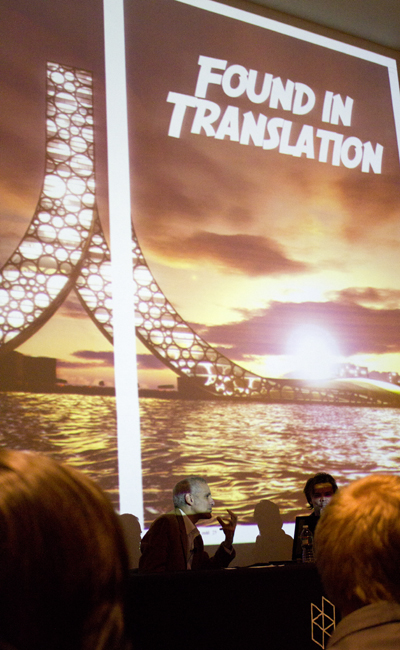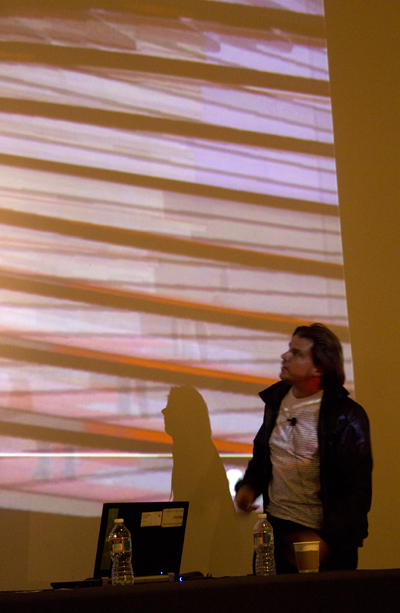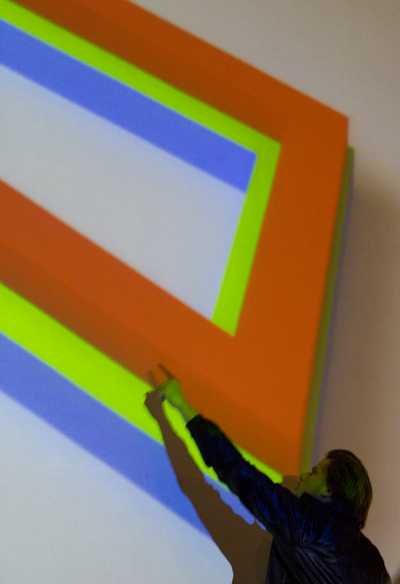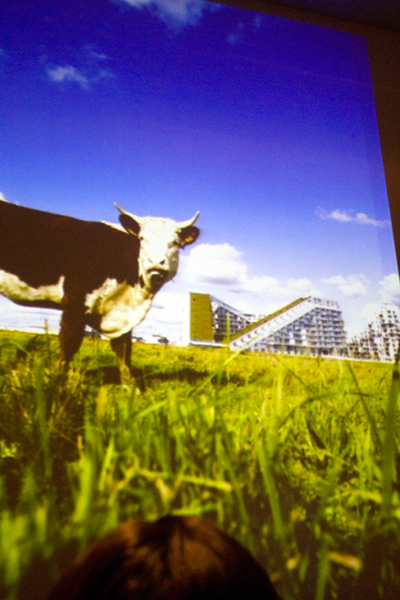
Hello Archinect!
Please bear with me for an experiment tonight, as I attempt to live blog Scott Cohen's discussion with Bjarke Ingels. Even this late in the semester, the house is packed and the mood is buoyant. Not, the consensus seems to be, because Bjarke is that important of an architect, but because he's that entertaining, and watching him spar with Scott just might be the best show of the semester.
We want a K.O., Scott! No winning on a technical, okay? Okay, go!
6:35 pm
PSC: We have tonight Bjarke, who agreed to... [PSC chuckles]...subject himself...to what will hopefully be another critical discussion.
6:40 pm
BI: I actually always hated Philip Johnson, I don't think he's a good architect. But I appreciate his willingness to embrace anything--
PSC: You really don't think he's a good architect?
BI: I went...with Barry Bergdoll on a visit to the Glass House, and the detailing was horrible. Once, Mies was there and was pointing out all the faults. He refused to sleep in the guest house and had to be driven to a hotel.
6:45 pm
PSC is asking BI why he included Darwin in his book: "What is this about the survival of the fittest, because I want to ask you something about that?"
BI: ...Only those specimens that have enough desirable attributes to survive long enough to mate, only they make it. And it's like that in our office: we make models and we literally try to mate them. And some of the offspring are hopeless misfits or abortions, but others-- well, instead of taking things and separate them into different boxes, I like to deal with the overlap, to find a whole fertile territory there--to not keep things in different camps.
PSC: But this whole idea of having camps. You don't have them [in Denmark]. You're inventing your own opposites and then resolving them.
[...]
6:50 pm
BI: But in my mind, a compromise is a situation where everyone is unhappy. So instead of forcing everyone to be unhappy...because when you add so much program, there's so much going on that a standard solution won't work. It's like an architectural game of twister. You know, that social game where you have to put your head between your--
PSC: But do you want the author to be-- [BI checks his iPhone] --present or absent?
BI: We don't want to force preconceived notions on the world, because the world is already happening, so we have to find a way to channel these energies of the world within the form of the world. And we are...the midwives.
PSC: Yes, that's what I had in mind. I thought you were interested in midwifery. But if that [the slide shows the People's Building in Shanghai, which looks like the Chinese character for "people"] is not willful--I mean, you can't say that's just the result of forces. [People's Building in Shanghai]
[People's Building in Shanghai]
BI: ...So you know, the giraffe has a long neck and the turtle has a shell... And there's sexual selection too. Take the peacock. There's nothing more inefficient than dragging this giant tail around, but you know, the girls like it. And it works. And the girls think he must be a very strong and healthy individual to drag that tail around.
PSC: OK, but this is the old model of the architect, the singular heroic architect who [enacts existing power structures]. And to do that in China, where power is centralized... what does that mean? This is China. I mean, what do you think I'm doing there? I know what it's like. And you're there too.
BI [I'm not sure if Bjarke tried to answer this question, but he segued quickly into the following]: ...So one of the other main aspects of evolution is migration. So there was a fish, and then it had flippers, and then it had legs. And in this project, at one point we had the promenade going through the legs... but it [didn't work] and we refined it later. [Ledoux]
[Ledoux]
PSC: You have said before that at first you were uncomfortable with the literalness of this building as a character, but that later you embraced it. Is that right? [...] And you continue with this idea of the enormous form. And I'm curious about the lineage here, and it doesn't have so much to do with [mating one thing with another] but with this: Ledoux' idea of architecture parlante, the idea that architecture speaks. And then the next step literally makes architecture into text [the slide is Johann David Steingruber, an 18th century German architect who made plans in the form of letters]. And the next step is this: [a slide of a contemporary project in the form of letters]. [Johann David Steingruber]
[Johann David Steingruber]
And you're making the next step after that. [...] It [isn't language], it isn't a logo. I would argue it's just a representation of a logo, because it isn't performing as a logo does. So what does it mean to you for architecture to be literally figured as symbols? I mean, you are invested in this. It's a pure semiotic--
BI: Well [...] we simply couldn't resist. Instead of having these respond purely to developer needs...
PSC: But what if these weren't legible? What if they were inscrutable? Like Steingruber, he hides the letter in the plan. You don't see it. You could have done that--like Koolhaas does--and made the shape lose its legibility. They're still interesting shapes. You can't say Koolhaas' shapes aren't interesting. Why are yours so literal? And the way they all look like cartoons, it's part of the...gestalt...
BI: I mean, you start with a masterplan, and you try to imbue it with a symbolic force...
PSC: But where there is a need to represent power, frankly, especially in the Chinese context, you make it into a figure.
BI: But the mountain itself leads to iconography. [Explaining something about a perimeter block.]
PSC: But there's a big difference between a perimeter block and a building that looks like a mountain, Bjarke.
BI: What is the difference? A building that looks like a mountain is a type.
PSC: That's where we disagree. [audience laughter] You make a building in a turkey shape, and you fill it up with architecture. Type is what fills up cities; it's the gray goo that you're talking about. How can you say that they're the same thing? Come on. Let's look at Steingruber. There is nothing here that is outside of its type; it's beautiful. But this [turning towards a Robert Somol diagram] is you: you take a shape, and then adapt to it. I don't think you can claim that your shapes are the result of forces.  [One of Bjarke's videos]
[One of Bjarke's videos]
7:20 pm
Having taken that line of inquiry as far as it was going to go (and probably a bit farther), Scott is letting Bjarke present his work for a few minutes. Bjarke is now back in his element, and immediately shows a striking video showing a sequence of some 92 different forms plugged into a site model. He is talking about iterating (or in his words, "mating"...). He's making a case for how his forms aren't willful from the beginning, even though the end result looks so willful, but rather, that the forms evolve as they work through the needs of the project.  [Part of the series of diagrams for the Copenhagen project]
[Part of the series of diagrams for the Copenhagen project]
Turning to another project, Bjarke is explaining how in Copenhagen, instead of expressing diversity by creating "a kind of faux streetscape of townhouses," they thought about the programmatic diversity, and stacked apartments on top of commercial spaces at the ground level, but allowed for a setback and green space, and then stacked other things on top of that, etc. And he goes through a series of operations on this figure-eight perimeter block diagram, which becomes a building accessed through a winding street that wraps up along the entire figure eight. I'm not sure if this still acts exactly like a street (in its publicness, its diversity, its degree of animation), but it's a pretty incredible project. Or maybe I'm just wowed by the cheerful diagrams and the video.  [Copenhagen project]
[Copenhagen project]
7:42 pm
Bjarke wants to show us one last thing: a drive- and fly-by video of a new project for which he's just applied for excavation permits. He describes it as a mating between a European type (of the courtyard apartment) and an American type (of the tower). The soundtrack is Jay-Z's 'Empire State of Mind'! The whole presentation has been over the top, but this takes it.
Scott is turning it over to questions now.
Student question: I love comics books, and when I read Tintin as a kid, I'd always turn to the back to find out what the next title is. So what's next?
BI: It's the evil twin of the first book.
PSC: More is Less?
BI: I can't say. I signed a non-disclosure agreement.
7:50 pm
The tone just got a bit serious: In response to another student question, BI is describing the influence of Douglas Coupland on him. He's saying that Coupland monitors aspects of life, pays attention to culture, and somehow gives it back to us. And Bjarke is making the case that architecture is that which mobilizes certain aspects of daily life in a way that, once you've seen it, you can't shake it off.
Another audience question: This is in reference to your figure-eight building [in Copenhagen]. You've only talked about the evolution of your buildings before they're built. But what about after?
BI: In a way, the architect's job is over when you hand over the keys. But we're very interested in what happens when social life takes over our projects. That's just not where our commissions come from.
PSC: Bjarke, I think we're getting close to a...concluding condition here. But do you have any last comments? If you have any thoughts about the future--
BI: I think the bottom line of our explorations so far is that...you have the demand to come up with stuff constantly. As an architect, you get called, and you have to pull something out of your...rear end, or wherever it comes from. But there's a constant process--and you don't have to look for something mystical to arrive at something interesting. If you look and listen carefully, the world is full of interesting things. If you can relegate yourself to the role of the midwife and be conceptually promiscuous enough to embrace different things, then it is limitless.
Show's over! Scott definitely won on technical (i.e. the theory), but with his diagrams, slick videos, and enthusiastic language, Bjarke held his own, on his own terms. A good time was had by both the Bjarke-lovers and the Bjarke-haters and now, now... I must get back to studio.
We have a pin-up tomorrow; it's "just an internal pin-up" but the internal critic is Dean Mostafavi.
Thanks for reading!
Lian
P.S. For a taste of Bjarke: http://vimeo.com/3499612
[Addendum as of 11/11/10: I should add that since I was blogging this live, the deviations in my text, from the actual words spoken, are probably a bit greater than usual. I don't check my texts against audio recordings, so it's a bit imprecise, but I always do my best to represent both the overall sense and the specific language whenever possible.]
This blog was most active from 2009-2013. Writing about my experiences and life at Harvard GSD started out as a way for me to process my experiences as an M.Arch.I student, and evolved into a record of the intellectual and cultural life of the Cambridge architecture (and to a lesser extent, design/technology) community, through live-blogs. These days, I work as a data storyteller (and blogger at Littldata.com) in San Francisco, and still post here once in a while.



18 Comments
I can't not hear Bjarke's awesome accent when I read his words! I'm such a silly American that way - we love accents.
"A concluding condition". Excellent.
Thanks, Lian!
i'm with donna. his accent is awesome and i somehow bring his inflection into the reading.
thanks for posting this, was an interesting read, lian.
Thanks Donna and holz.box! I've been seeing Bjarke around the trays, but this was the first time I've heard him speak, and I have to say, I found it hard not to like him even if his architecture isn't really my cup of tea. He's just so funny...in so many ways.
no is less
Nice blogging.
It would seem to me that Bjarke is able in his discussion of midwifery and mating to offer a clear and powerful statement of his theory (of practice). While PSC is interested in Theory in terms of meaning and criticality. Personally, the one is more compelling to me than the later. BIG's forms are definitely legible and offer a form of symbolism, yet to me they symbolize a process not an idea.
In terms of concluding condition. I think that is perhaps, literally where it ends up. The idea of post-occupancy and the designers relationship to such concerns is key i think to helping expand fields. Social life is literally the next condition after the design process. Hopefully, not the final one though.
Thanks for sharing.
I agree with nam, and it should seem especially important to Bjarke since many of his projects are unprecedented in their spatial relationships. If it turns out that these concepts are not working in practice, he may need to start 'mating' different ideas...
I thought by "concluding condition" PSC meant "we're out of time".
But I like your reading much, much better, nam!
thanks for the blogging !
sounded like bjarke was just not interested in some of those questions. gotta live him if only for that.
his office's work is hard to pin down since it really doesn't come from anywhere, even with the process concept. if you look at the site of the 8 building its cool to notice that all of the conditions they are responding to are imagined. there aren't even streets really. its a building that premembers the future. but it still doesn't feel fake, which is a pretty good trick.
the work looks shallow, and kind of is, but then its rich too. maybe he and his office form the roy lichtenstein wing of architecture?
I think Preston won the 'debate' hands down. Whilst I appreciate that BIG's work is not all formulaic nor mimetic, BI's powers of logic and exposition are subservient to PSC's. At least in a text based medium.
Also, side note: BIG's work IS [often] a one liner, and PSC's is [often] very specific, contextual and layered. And even beautiful.
seriously? PSC "won"? what does that mean in a discussion of this nature anyway? PSC may have had the appearance of an upper hand because he posed the questions, but in my mind he offered no opposing perspectives worth elaborating on.
if we're talking about who was more eloquent in presenting their archi-babble then PSC can take home that prize. but if we're talking about which architect's theories of has more relevance to the people that inhabit the spaces they create, then Mr. Ingels will take that one almost every time.
isn't that what the purpose of all debates like this are meant for? is it to re-assure all the aspiring architects in the crowd that they are copying the right precedents? or should they be for determining the relevancy of the theories that each particular architecture is offering to the rest of the world?
as for the reporting method--while at sometimes subjective, it is a very refreshing way to hear about architectural presentations as a sort of "play by play". architecture and sports have much more in common than most people think. ; ]
thanks for posting
Thanks, everyone, for your comments! I really appreciate it, and I'm glad to see that there are such different opinions on how things went based on what I was able to report to you. It means my post wasn't totally one-sided. :)
What archaalto mentions is true: I realized in this post that as hard as I try, my quotations are subjectively edited. Because I'm pretty used to how my professors talk by now, so it's fairly easy for me to get their words and ideas down as they speak. But for those whose thought processes, phrasing, and accents are new to me--well, I don't get everything down as quickly, so it's difficult to represent them equally well. I've experimented with making audio recordings, but my equipment (iPhone) is not so good and I find it's not that helpful.
So there's a bit of a home field advantage for Hays and PSC and Kwinter and the other GSD profs. But I'll keep working on this. :)
i saw something similar between Ingels and Mark Wigley at the Van Alen Institute a couple/3 years ago. Seemed less like a winner/loser, as Wigley pointed out some reactions to BIG/PLOT's work and general attitude, and Ingels responded. No "questions" were ignored, and in general the scene was critical but friendly in the most productive sort of way. Wigley was able to be incisive without talking down, and Ingels responded with a genuine, at times 'caught-off-guard' sort of demeanor. if anyone reading was there (at the Van Alen), would love to hear your reaction...
this seemed like fun - I sure wish I experienced it live.
jplourde, I think Bjarke's built work ends up being *much* more nuanced and multivalent than the presentation renderings, which do sometimes have a one-liner reading - a "gotcha" that ends up delivering more later.
I don't know anything about PSC's actual work to compare, though.
where is the big tie?
The question is, is he building Megastructures or something else?
It's funny BI says that about the detailing of the glass house, when I just visited the 8 the other week and noticed that the detailing was awful. Pointy metal corners, handrails that don't meet up mid-stair, endless cheap rivets, hvac systems coming out into the corner of rooms and having to be patched up with drywall, water pipes projecting out of walls and back into them.
Of course it's not totally finished yet, so maybe these things will be resolved?
What did he say about the glass house?
Block this user
Are you sure you want to block this user and hide all related comments throughout the site?
Archinect
This is your first comment on Archinect. Your comment will be visible once approved.